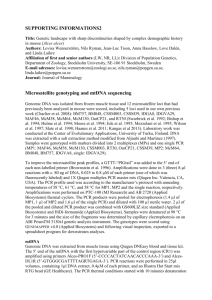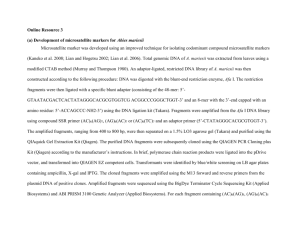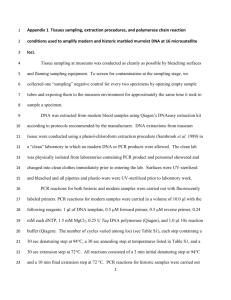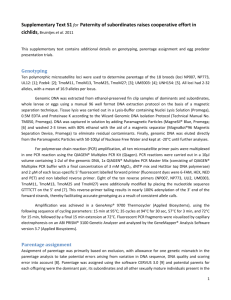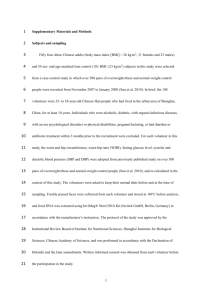Supplementary Methods - Springer Static Content Server
advertisement
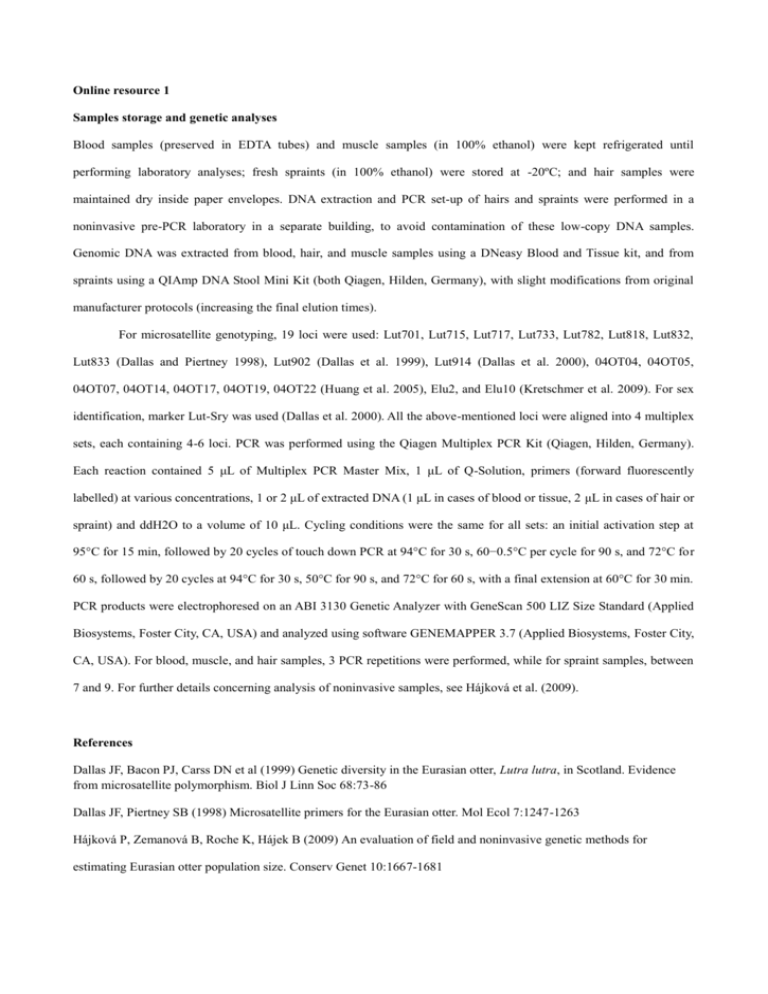
Online resource 1 Samples storage and genetic analyses Blood samples (preserved in EDTA tubes) and muscle samples (in 100% ethanol) were kept refrigerated until performing laboratory analyses; fresh spraints (in 100% ethanol) were stored at -20ºC; and hair samples were maintained dry inside paper envelopes. DNA extraction and PCR set-up of hairs and spraints were performed in a noninvasive pre-PCR laboratory in a separate building, to avoid contamination of these low-copy DNA samples. Genomic DNA was extracted from blood, hair, and muscle samples using a DNeasy Blood and Tissue kit, and from spraints using a QIAmp DNA Stool Mini Kit (both Qiagen, Hilden, Germany), with slight modifications from original manufacturer protocols (increasing the final elution times). For microsatellite genotyping, 19 loci were used: Lut701, Lut715, Lut717, Lut733, Lut782, Lut818, Lut832, Lut833 (Dallas and Piertney 1998), Lut902 (Dallas et al. 1999), Lut914 (Dallas et al. 2000), 04OT04, 04OT05, 04OT07, 04OT14, 04OT17, 04OT19, 04OT22 (Huang et al. 2005), Elu2, and Elu10 (Kretschmer et al. 2009). For sex identification, marker Lut-Sry was used (Dallas et al. 2000). All the above-mentioned loci were aligned into 4 multiplex sets, each containing 4-6 loci. PCR was performed using the Qiagen Multiplex PCR Kit (Qiagen, Hilden, Germany). Each reaction contained 5 μL of Multiplex PCR Master Mix, 1 μL of Q-Solution, primers (forward fluorescently labelled) at various concentrations, 1 or 2 μL of extracted DNA (1 μL in cases of blood or tissue, 2 μL in cases of hair or spraint) and ddH2O to a volume of 10 μL. Cycling conditions were the same for all sets: an initial activation step at 95°C for 15 min, followed by 20 cycles of touch down PCR at 94°C for 30 s, 60−0.5°C per cycle for 90 s, and 72°C for 60 s, followed by 20 cycles at 94°C for 30 s, 50°C for 90 s, and 72°C for 60 s, with a final extension at 60°C for 30 min. PCR products were electrophoresed on an ABI 3130 Genetic Analyzer with GeneScan 500 LIZ Size Standard (Applied Biosystems, Foster City, CA, USA) and analyzed using software GENEMAPPER 3.7 (Applied Biosystems, Foster City, CA, USA). For blood, muscle, and hair samples, 3 PCR repetitions were performed, while for spraint samples, between 7 and 9. For further details concerning analysis of noninvasive samples, see Hájková et al. (2009). References Dallas JF, Bacon PJ, Carss DN et al (1999) Genetic diversity in the Eurasian otter, Lutra lutra, in Scotland. Evidence from microsatellite polymorphism. Biol J Linn Soc 68:73-86 Dallas JF, Piertney SB (1998) Microsatellite primers for the Eurasian otter. Mol Ecol 7:1247-1263 Hájková P, Zemanová B, Roche K, Hájek B (2009) An evaluation of field and noninvasive genetic methods for estimating Eurasian otter population size. Conserv Genet 10:1667-1681 Huang C-C, Hsu Y-C, Lee L-L, Li S-H (2005) Isolation and characterization of tetramicrosatellite DNA markers in the Eurasian otter (Lutra lutra). Mol Ecol Notes 5:314-316 Kretschmer EJ, Olsen JB, Wenburg JK (2009) Characterization of eight microsatellite loci in Sea Otter, Enhydra lutris, and cross-species amplification in other Mustelidae. Conserv Genet 10:775-777
